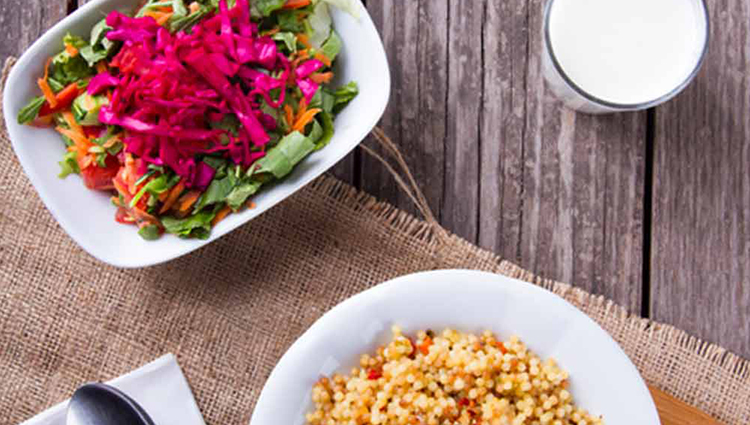Plant-based or plant-forward diets are trending these days, but many people misunderstand “plant-based” to mean “animal-free”; and that is not necessarily the message or the goal. In fact, dairy products and other animal foods are a core component of several nutrient-rich eating patterns highlighted in the 2015-2020 Dietary Guidelines for Americans (DGA). Dairy foods contribute vital and under-consumed nutrients – and adding them to a plant-focused meal can add a lot of taste and nutrition. Let’s highlight what dairy adds and how it is easily incorporated into a healthful eating pattern.
The Unmatched Nutrition of Dairy
One thing you may not know about the current DGAs is that the 2015 Dietary Guidelines Advisory Committee (DGAC) report recommended eating a more plant-based dietary pattern, but emphasized one that includes all five food groups. The report recommends an eating plan that is rich in vegetables, fruits, whole grains, seafood, legumes, nuts, and low-fat and nonfat dairy products; moderate in alcohol (among adults); lower in red and processed meat; and low in refined grains and sugar-sweetened foods and beverages.
Dairy foods are fundamental to all the various healthy eating patterns highlighted in the DGAs (including the Healthy U.S.-Style Eating Pattern, Healthy Vegetarian Eating Pattern and Healthy Mediterranean-Style Eating Pattern) because of the important nutrients they bring to the table. Not to mention that these healthy eating styles, which include dairy foods, are linked to numerous health benefits. Eating three servings of dairy a day remains the recommendation:
- Low-fat and fat-free dairy foods – such as milk, cheese and yogurt – as part of healthy eating styles have been linked to health benefits, such as reduced risk of cardiovascular disease and Type 2 diabetes. In addition, dairy foods have been linked to improved bone health in children and adolescents.
- Dairy foods provide key nutrients that can be hard to replace with other foods in a healthy diet. With 13 essential nutrients – including calcium, phosphorus, vitamin A, vitamin D, riboflavin, vitamin B-12, pantothenic acid, niacin and high-quality protein – dairy delivers a nutrient-dense bang for your buck.
- Dairy delivers three of the four nutrients of public health concern (nutrients adults and children most often fall short on): vitamin D, calcium and potassium. When underconsumed, they are linked to adverse health outcomes.
Challenges of Solely Plant-Based Diets
Trendy diets – like veganism, paleo, ketogenic and Whole 30® – focus on eliminating foods and food groups; yet each food and food group has a unique set of nutrients important for overall health. For individuals who ditch dairy and other animal foods, they could also be ditching essential nutrition. Keep in mind that:
- High-quality proteins from animal food sources are complete, meaning they provide all of the essential amino acids. Other protein sources, such as fruits, vegetables, grains, nuts and seeds, may lack one or more essential amino acids. Protein complementation is needed for our vegetarian clients.
- Dairy foods are an important source of vitamin B12 – a nutrient primarily found in animal products.
- Eliminating animal foods can lead to an unbalanced plate. A 2016 study showed that when people ate diets that contained only plant-based foods, a great number of nutrients fell below recommended levels – most notably calcium, vitamins A and D, and B12. Another study concluded that a mix of dairy foods and plant-based foods had the best chance of closing nutrient gaps to support healthier Americans.
- Solely plant-based diets may not be the solution for a healthier planet. A sustainable modeling study showed minimal reduction in greenhouse gas emissions when animals were removed. One reason is that without animal agriculture, there is no manure. Manure keeps the soil healthy and helps us grow plants without man-made fertilizers. Nutrition and environmental science are two complex disciplines, but finding the right way to use our resources is key. Making it a battle of plant foods versus animal foods may not benefit our planet or public health.
Better Solutions for Your Clients
A better plan may be to find one of the DGA’s healthy eating patterns that fits your client’s lifestyle. The DGA’s emphasis on healthy eating styles — and how nutrient-rich foods work together to meet nutritional needs — makes it easy for everyone to personalize their plate and develop healthy, sustainable eating patterns. Translating the science to your clients is as simple as using MyPlate, the Dietary Guidelines translated into consumer-friendly messaging.
Or, try the DASH eating plan. DASH, which stands for Dietary Approaches to Stop Hypertension, was originally developed by the National Heart, Lung, and Blood Institute to help lower blood pressure without medication. This year (2018) is the 21st anniversary of a landmark clinical trial published in the New England Journal of Medicine:
- The research shows not only that it achieved the goal to lower blood pressure, but that other aspects of health improved as well, such as aiding in weight loss, controlling blood sugar in diabetes and reducing cancer risk.
- In one 2010 study, published in the JAMA: The Journal of the American Medical Association, adults were assigned to one of three approaches: DASH, DASH plus exercise and weight loss classes, and a control diet where participants maintained their usual eating habits. After four months, those in the DASH plus exercise group lost an average of 19 pounds, while the other groups either lost a little or gained weight. Subsequent studies all showed similar results.
Year after year, DASH is named the No. 1 diet by U.S. News & World Report. Why? Many diet plans are too difficult to adhere to long term. The DASH focus is sustainable because it adds foods instead of depriving dieters. It focuses on a new eating plan and not just a short-term goal. Low-fat and fat-free dairy is a critical component of DASH, but this diet also encourages a great number of fruits and vegetables. It should be attractive to those who are seeking out a more plant-based or plant-forward plate.
Plant-based doesn’t mean animal-excluded. Encourage your clients to find their best eating pattern. Learn more about dairy and plant-based diets.




